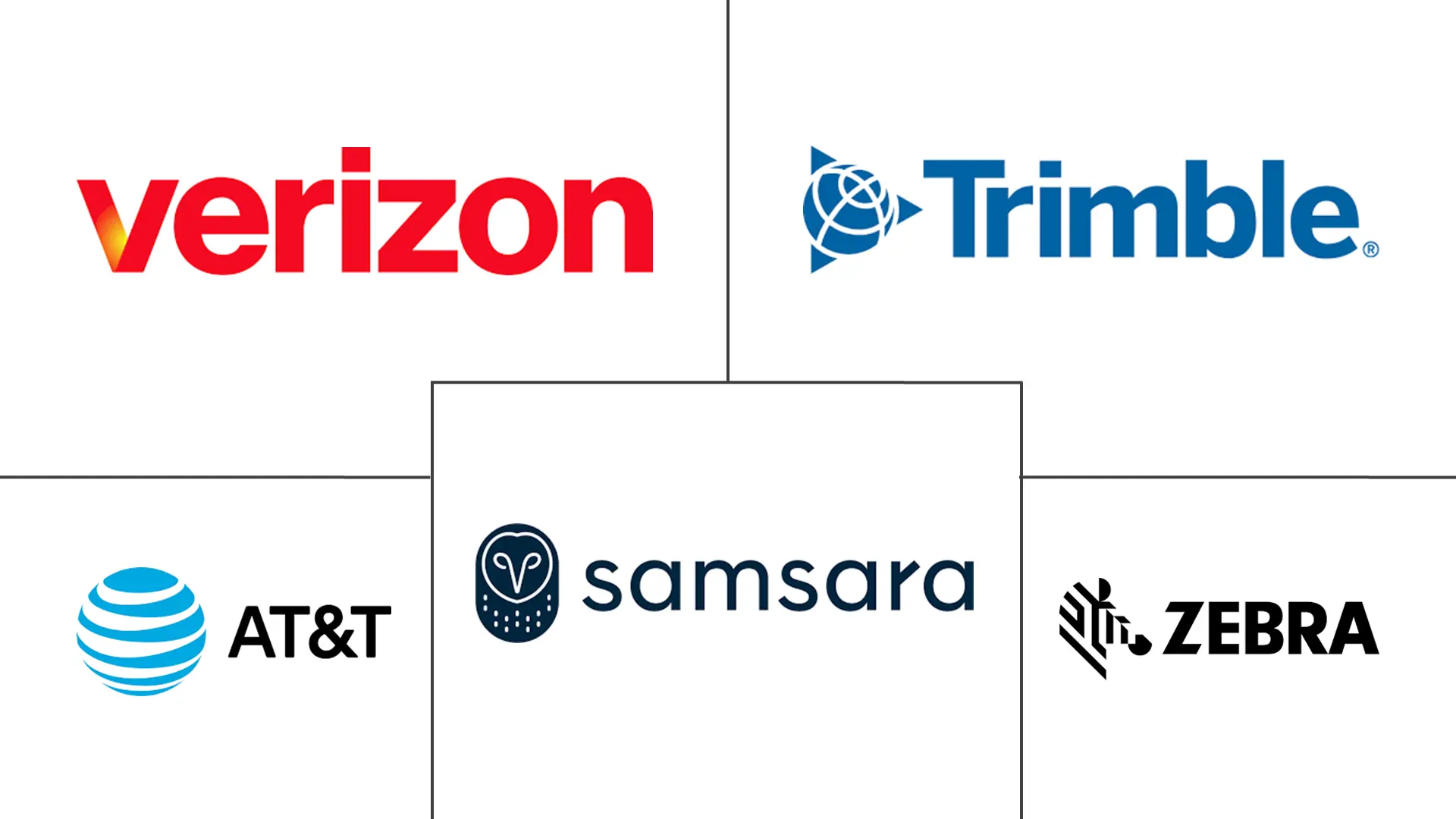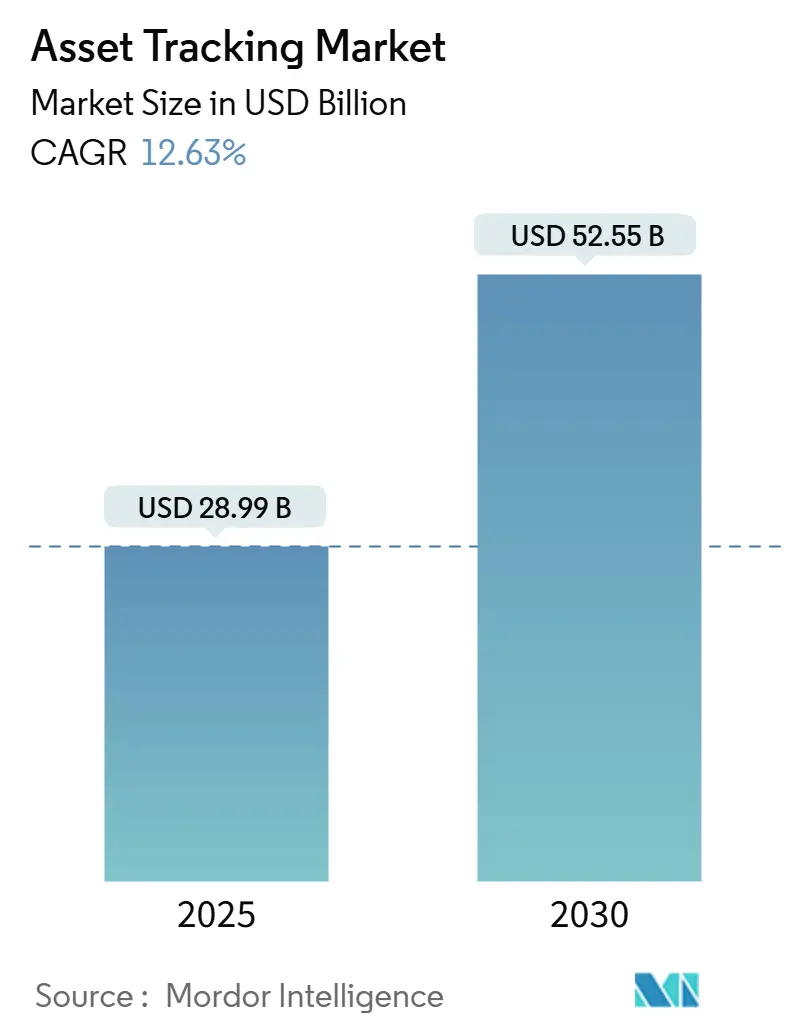
Asset Tracking Market Analysis by Mordor Intelligence
The Asset Tracking Market size is estimated at USD 28.99 billion in 2025, and is expected to reach USD 52.55 billion by 2030, at a CAGR of 12.63% during the forecast period (2025-2030). Rising e-commerce volumes, accelerating 3PL outsourcing, and falling IoT sensor prices are converging to lift adoption rates across industries. Enterprise surveys show that real-time transportation visibility has been the top capability priority for seven consecutive years, underscoring how mission-critical location intelligence has become. Cargo-theft losses spiked to 3,625 incidents in 2024, up 27% year on year, reinforcing insurance mandates for always-on tracking. Cloud deployment models dominate new rollouts because subscription pricing aligns technology costs with shipment volumes, while AI-powered platforms exploit cheaper sensors to weave predictive analytics into day-to-day operations. Competitive intensity is increasing as satellite-IoT constellations unlock coverage in remote regions and telematics incumbents race to embed multi-sensor fusion for sub-meter accuracy.
Key Report Takeaways
- By component, software held 61.90% of the asset tracking market share in 2024, whereas hardware is expanding at a 13.12% CAGR through 2030.
- By deployment model, the cloud segment captured 72.00% revenue in 2024 and is poised to compound at a 13.20% CAGR to 2030.
- By end-user, transportation and logistics led with 28.50% share of the asset tracking market size in 2024, while food and beverage is advancing at a 14.50% CAGR through 2030.
- By asset type, fleet vehicles accounted for 33.99% of the asset tracking market size in 2024, and high-value portable assets are forecast to accelerate at a 13.98% CAGR up to 2030.
- By geography, North America commanded 39.90% revenue in 2024; Asia Pacific is set to climb at a 15.90% CAGR between 2025-2030.
Global Asset Tracking Market Trends and Insights
Drivers Impact Analysis
| Driver | (~) % Impact on CAGR Forecast | Geographic Relevance | Impact Timeline |
|---|---|---|---|
| Expansion of 3PL and e-commerce logistics requiring real-time visibility | +3.2% | Global, concentrated in North America, Europe, Asia Pacific | Medium term (2-4 years) |
| Falling IoT sensor and GPS-tracker costs | +2.8% | Global | Short term (≤ 2 years) |
| Escalating global cargo-theft losses driving insurer-mandated tracking | +2.1% | Global, highest in North and Latin America | Short term (≤ 2 years) |
| AI-powered multi-sensor fusion boosts indoor/outdoor accuracy | +1.9% | North America, Europe, developed APAC | Medium term (2-4 years) |
| Satellite-IoT constellations unlock remote-area tracking | +1.6% | Global, remote regions and developing markets | Long term (≥ 4 years) |
| Regulatory mandates for cold-chain and pharma traceability | +1.1% | North America, Europe | Medium term (2-4 years) |
| Source: Mordor Intelligence | |||
Expansion of 3PL and e-commerce logistics requiring real-time visibility
Exploding parcel volumes and omnichannel fulfillment complexity are pushing shippers toward outsourced networks that run on continuous location intelligence. A benchmark survey found organizations framing transportation as a “competitive weapon” are 3.4 times likelier to rank as top performers, while 75% expect to lift IT budgets specifically for visibility tools. Truckload and LTL modes see the sharpest demand, as precise ETAs shrink dwell times and drive asset utilization. Subscription-based fleet software, growing 15.6% annually through 2029, further lowers entry barriers for mid-sized shippers. Collectively, these forces funnel a steady stream of new users into the asset tracking market as logistics providers embed tracking into customer service level agreements.
Falling IoT sensor and GPS-tracker costs
Entry-level GPS devices now retail for USD 12-39, while multi-sensor tags offering cellular fallback and five-year batteries have dipped below USD 60, cutting payback periods for theft-prone assets. Battery chemistry advances extend device life to seven years, trimming maintenance cycles and field-service costs. Edge-ready chipsets preprocess data, so only exceptions flow to the cloud, slashing bandwidth fees. Construction, healthcare, and light-industrial firms are therefore equipping forklifts, medical carts, and rental gear at scale, swelling the installed device base and deepening the asset tracking market footprint.
Escalating global cargo-theft losses driving insurer-mandated tracking
Average losses reached USD 202,364 per event in 2024, with California thefts up 33% and Texas up 39% [1]Security Industry Data, “2024 Cargo Theft Report,” securityindustrydata.com. Insurers now stipulate multi-layer solutions combining GPS, cellular, and satellite links, plus tamper-evident enclosures, as a condition for high-value shipment cover. The mandate removes budget objections for security-critical lanes and funnels predictable premium savings into tracking subscriptions. Vendors are responding with dual-mode LTE-satellite devices that auto-switch when GNSS jamming is detected, keeping position feeds live for claims adjudication.
AI-powered multi-sensor fusion boosts indoor/outdoor accuracy
Machine-learning engines blend GPS, Wi-Fi RTT, Bluetooth LE, and inertial data to sustain sub-meter accuracy inside warehouses and urban canyons. Predictive models learn habitual movement routes and flag anomalies before assets drift from geofenced zones, cutting search times for misplaced equipment by up to 90%. In healthcare pilots, AI analytics shaved unplanned downtime by 40% by triggering maintenance alerts based on vibration signatures. Edge inference chips embed the intelligence on-device, ensuring real-time verdicts even when cloud links stall, a feature critical for mission-critical cold-chain hand-offs.
Restraints Impact Analysis
| Restraint | (~) % Impact on CAGR Forecast | Geographic Relevance | Impact Timeline |
|---|---|---|---|
| High upfront hardware and integration costs for SMEs | -2.3% | Global, higher in developing markets | Short term (≤ 2 years) |
| GNSS jamming/spoofing incidents raise liability risk | -1.8% | Global, conflict zones and high-crime corridors | Medium term (2-4 years) |
| Data-privacy laws limit location-data monetization | -1.4% | Europe, North America | Long term (≥ 4 years) |
| Spectrum congestion for LPWAN and satellite bands | -1.1% | Urban areas in developed markets | Medium term (2-4 years) |
| Source: Mordor Intelligence | |||
High upfront hardware and integration costs for SMEs
Turnkey deployments routinely top USD 50,000 once devices, connectivity, and systems integration are tallied. Ongoing SIM fees and SaaS subscriptions widen the bill, while middleware workarounds inflate professional-services hours. SMEs in developing markets face the steepest hurdle because financing options are limited and technical talent is scarce. As a result, many postpone adoption until suppliers bundle tracking inside leasing contracts, slowing overall asset tracking market diffusion.
GNSS jamming/spoofing incidents raise liability risk
Cheap jammers bought online disrupt GPS receivers in seconds, rendering legacy devices blind along high-risk corridors. Mexico logged GNSS disruption in 85% of 2024 cargo-theft cases, and aviation near Delhi has experienced episodic spoofing that confuses air-traffic management. Legal clarity on liability remains elusive, so logistics providers shoulder higher insurance deductibles unless they deploy anti-jamming antennas and multi-constellation beacons. These added layers lift solution costs and complicate procurement cycles, tempering adoption among price-sensitive fleets.
Segment Analysis
By Component: Software integration anchors growth
Software solutions generated 61.90% revenue in 2024, reflecting the premium enterprises place on analytics-rich platforms. Integrated dashboards pull data from GPS tags, RFID portals, and video telematics, giving operators a single window into network performance. Edge-enabled firmware now filters sensor noise, freeing cloud CPUs for machine-learning workloads that model dwell times and forecast maintenance events. Hardware, though smaller in value, is set to expand at a 13.12% CAGR through 2030 as device builders launch solar-assisted trackers and ruggedized enclosures for mining machinery. Extended 7-year batteries shrink OPEX and encourage broader asset coverage, lifting unit volumes and deepening the asset tracking market.
The software-hardware interplay is spawning “device-as-a-passport” concepts where tamper-proof IDs follow assets through reverse logistics loops. APIs that link tracking feeds to ERP, WMS, and TMS suites reduce manual reconciliation and shrink cycle counts. Vendors are also leveraging no-code workflow builders so operations teams can craft exception alerts without IT tickets, sharpening retention rates and calming churn in a fragmented supplier arena.
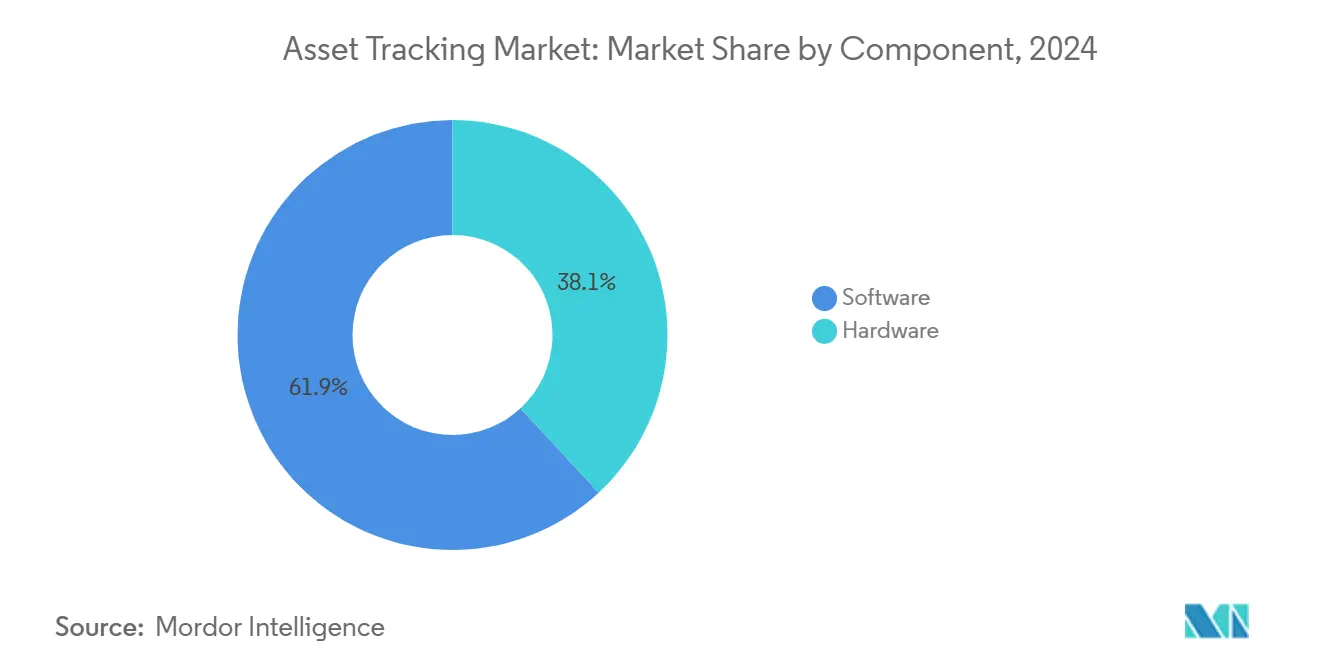
By Deployment Model: Cloud commands strategic budgets
Cloud deployments accounted for 72.00% of 2024 spending and are on track for a 13.20% CAGR. Multitenant architectures let providers amortize research and development across thousands of tenants, enabling rapid release cycles that drop AI enhancements quarterly. Usage-based billing appeals to mid-tier logistics firms that want to map fees to load volumes, a pricing model that accelerates entry and sustains renewal. Security certifications such as SOC 2 and ISO 27001 quell enterprise concerns, while zero-trust gateways throttle lateral movement between tenants.
On-premise nodes retain relevance in tightly regulated defense and energy sectors where air-gapped OT networks prevail. Hybrid footprints are emerging as control planes run in the cloud, but sensitive location payloads replicate to local databases for sovereignty compliance. That flexibility positions cloud-first vendors to cannibalize legacy appliance deals while defending turf against ERP giants embedding basic tracking into supply-chain suites.
By End-user Industry: Compliance fuels new verticals
Transportation and logistics held 28.50% of 2024 revenue after decades of telematics adoption. Hours-of-service mandates and fuel-tax reporting cement recurring demand, while dynamic routing and decarbonization dashboards layer fresh value propositions. The food and beverage segment, projected to record a 14.50% CAGR, is surging as the FDA’s FSMA Section 204 forces traceability on leafy greens, nut butters, and deli salads [2]U.S. FDA, “FSMA Final Rule: Requirements for Additional Traceability Records for Certain Foods,” fda.gov. Digital lot codes and temperature-chain alarms reduce recall scope and safeguard brand equity. Healthcare spending is expanding as hospitals chase inventory accuracy for invisible pumps and wheelchairs roaming campuses; RFID pilots show audit times plunging 95%, freeing biomedical staff for value-added tasks.
Manufacturing adoption centers on work-in-process visibility that flags bottlenecks and prevents misplaced tooling. The aviation vertical embraces ground-support-equipment tracking to enforce turnaround SLAs, while construction contractors rely on GPS tags for equipment rentals to cut idling fines and insurance premiums. Each vertical requires distinct sensor tolerances and data-model templates, pushing platform vendors to ship pre-configured modules tuned to sector lexicons.
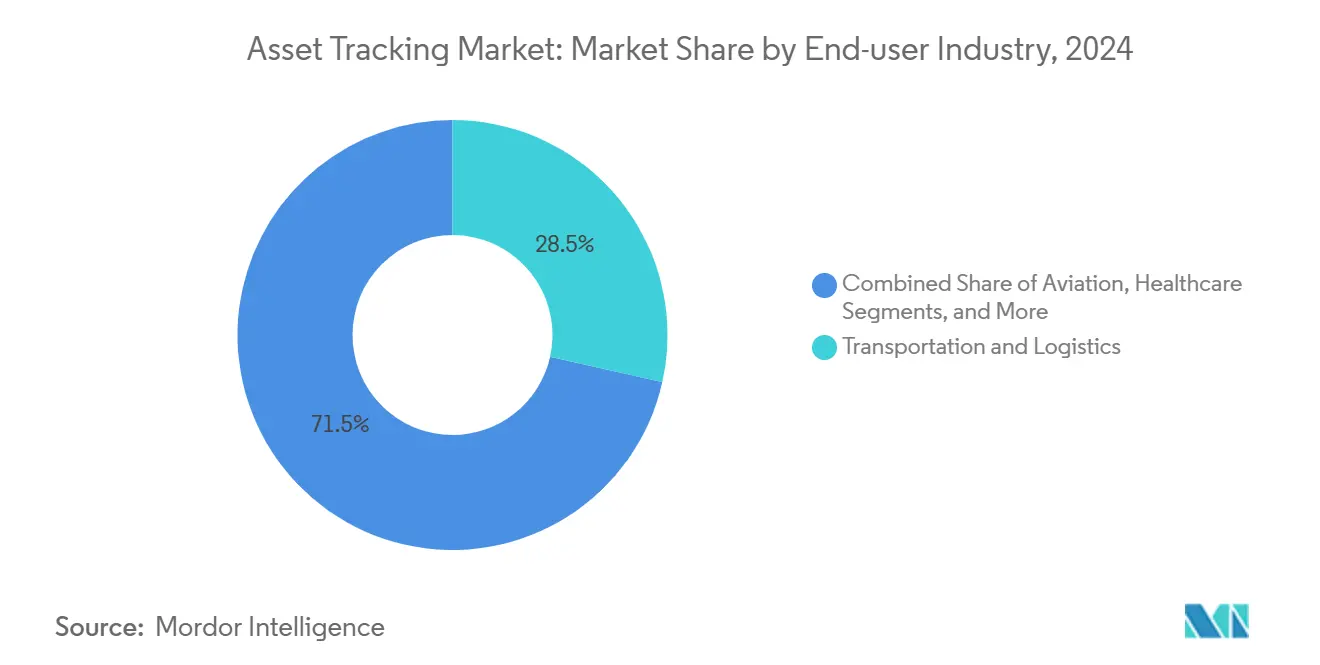
Note: Segment shares of all individual segments available upon report purchase
By Asset Type: High-value portables set the pace
Fleet vehicles represented 33.99% of the 2024 asset tracking market size, a legacy base built on ELD mandates and fuel-efficiency gains. Yet high-value portable assets, from medical scanners to luxury retail pallets, now post a 13.98% CAGR. Combined LTE-BLE tags clamp onto crates carrying USD 100,000 medical kits, auto-reporting shocks, and door opens that would void warranties. Trailer and container trackers are migrating to global satellite links to preserve coverage on trans-ocean voyages.
Heavy equipment sensors feed utilization dashboards that drive job-site scheduling and preventative-maintenance algorithms. Returnable transport items such as kegs and plastic pallets integrate sub-USD 5 chipsets, cutting loss write-offs and supporting circular-economy targets. Livestock collars track grazing patterns and body temperatures, allowing early illness detection and precise rotational grazing, thereby opening a new flank for the asset tracking industry.
Geography Analysis
North America retained 39.90% revenue leadership in 2024 on the back of dense 4G/5G coverage, mature ELD regulations, and DSCSA serialization rules for pharmaceuticals [3]U.S. FDA, “Drug Supply Chain Security Act (DSCSA),” fda.gov . Tier-one carriers such as AT&T now bundle SIM orchestration across 250 carriers via a single console, streamlining cross-border rollouts. While penetration is high, replacement cycles for 3G sunsets and AI upgrades sustain steady spend, though regional CAGR trails the global average.
Asia Pacific is the fastest climber at 15.90% CAGR through 2030. China alone hosts 2.7 billion cellular IoT links, 70% of the worldwide total, propelled by state-led smart-manufacturing programs. Indian e-commerce parcel volumes jumped 32% in 2024, pushing 3PLs to adopt GPS-enabled waybills to quell customer complaints about missed ETAs. Southeast Asian governments are subsidizing LPWAN deployments along industrial corridors, offering fertile ground for low-cost trackers on RTIs and motorcycle fleets.
Europe stakes its growth on regulatory catalysts. GDPR fines motivate firms to deploy on-device anonymization and policy-based geofencing. The bloc’s circular-economy directives encourage RFID tagging of plastic pallets to ensure recycling compliance. Meanwhile, the Middle East and Africa see pipeline, mining, and desert logistics use cases turning to satellite-IoT hybrids, given sparse cellular grids. Latin America contends with theft hotspots, yet mining and agribusiness operators are embracing ruggedized trackers to curb equipment pilferage, underscoring demand diversity across the asset tracking market.
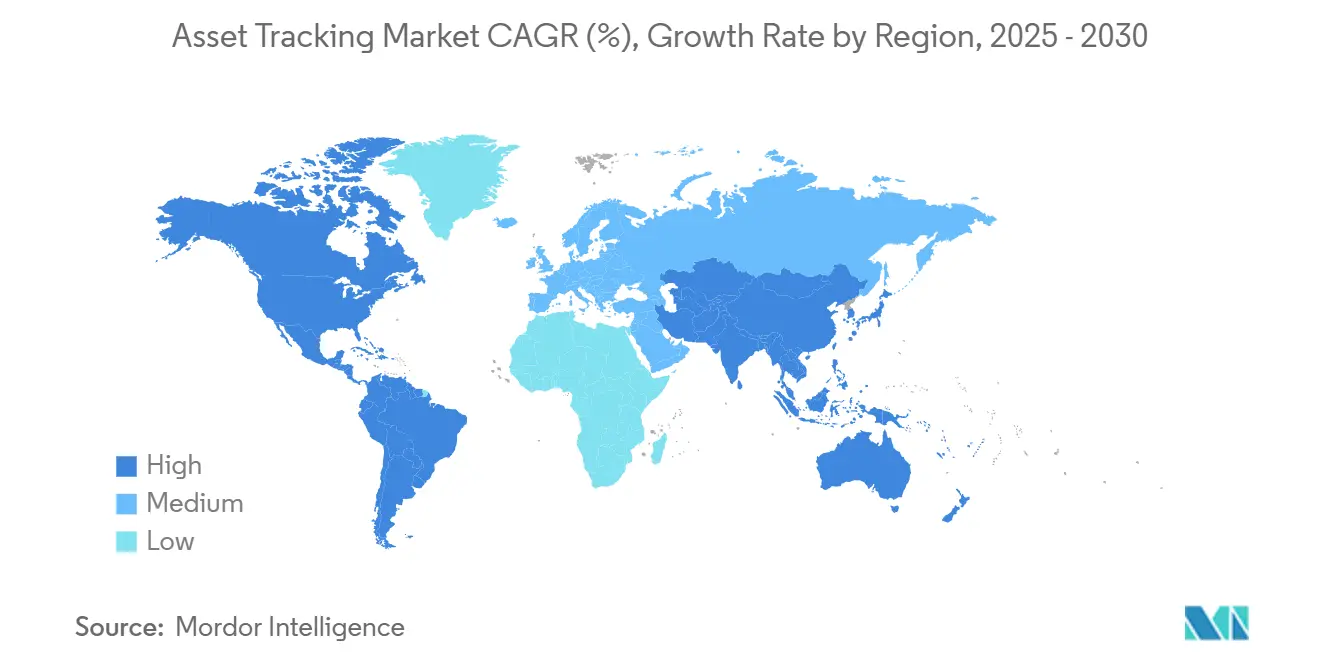
Competitive Landscape
The supplier base spans legacy telematics giants, AI-centric SaaS upstarts, and satellite-network aggregators. Powerfleet’s USD 200 million deal for Fleet Complete created a 2.6 million-subscriber portfolio with integrated video analytics. Platform Science purchased Trimble’s transportation telematics units, stitching hardware, software, and OEM integrations into a single virtual vehicle fabric. These moves reflect customer preference for unified stacks that simplify vendor management.
Differentiation pivots on AI inferencing at the edge, battery breakthroughs, and dual-mode satellite-cellular offerings. Start-ups targeting healthcare tout RFID-BLE blends that boost audit speeds 90-95%, saving large hospital trusts USD 3 million annually. Satellite-IoT specialists negotiate airtime in bulk to undercut traditional MSS pricing, extending visibility to polar shipping routes. Blockchain pilots are gaining traction for high-value luxury goods, providing immutable custody chains that deter counterfeits.
Vendor viability depends on multi-tenant security, verticalized analytics, and open APIs. As device costs fall, margin shifts to software and data services, nudging hardware-centric players toward recurring-revenue bundles. Competitive churn favors suppliers that offer phased migration from 2G sunset devices to LTE-M and NB-IoT without forklift upgrades, insulating customers against network obsolescence while anchoring long-term contracts in the asset tracking market.
Asset Tracking Industry Leaders
-
AT&T Inc.
-
Verizon Communications Inc.
-
Samsara Inc.
-
Trimble Inc.
-
Zebra Technologies Corporation
- *Disclaimer: Major Players sorted in no particular order
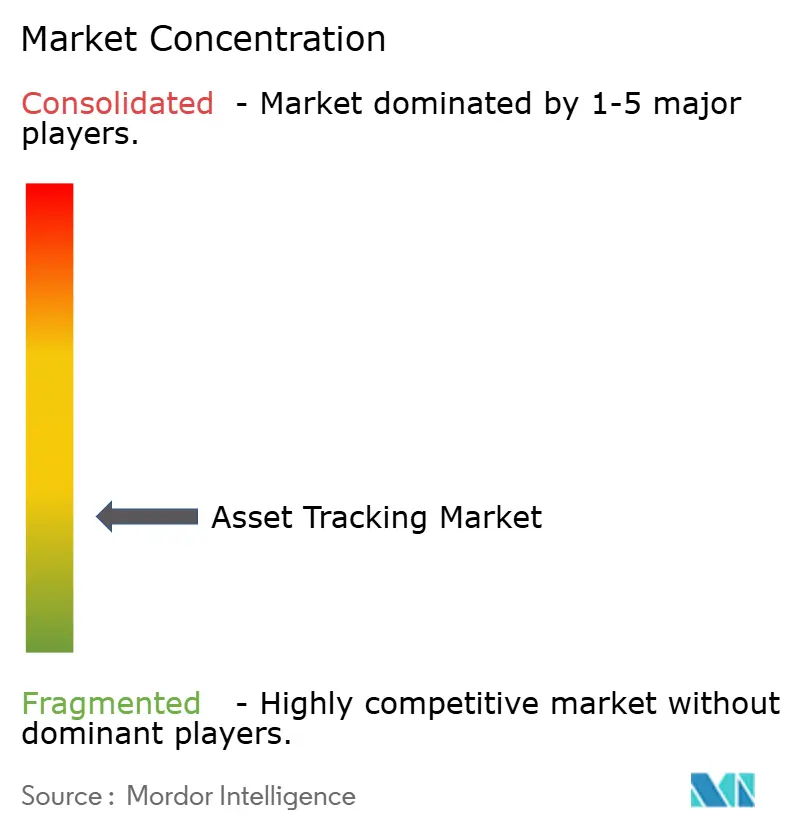
Recent Industry Developments
- March 2025: Verizon added Singtel and Skylo to its global IoT platform, expanding roaming choices for dual-mode trackers.
- March 2025: GCT Semiconductor and Globalstar teamed up to build dual-mode satellite-cellular modules for two-way asset tracking.
- February 2025: Verizon Business launched a turnkey IoT solution with the Atlanta Hawks, bundling connectivity, devices, and managed services into a single asset-tracking package.
- February 2025: Platform Science closed its acquisition of Trimble’s telematics assets, bolstered by investments from Daimler Truck and PACCAR.
- February 2025: Trimble unveiled Transporeon Visibility, delivering AI-driven ETAs within its TMS ecosystem.
- November 2024: AT&T and Simetric released IoT Console Single Pane of Glass, enabling unified SIM control across 250 networks.
- September 2024: Powerfleet finalized its USD 200 million Fleet Complete acquisition, adding 2.6 million subscribers and AI-video tech.
Research Methodology Framework and Report Scope
Market Definitions and Key Coverage
This study defines the asset tracking market as revenues generated when businesses deploy GPS, RFID, BLE, barcode, or QR-enabled hardware and linked software platforms to monitor location, status, and utilization of fixed and mobile assets across enterprise operations. According to Mordor Intelligence, the valuation of this integrated hardware-software opportunity reaches USD 28.99 billion in 2025.
Scope Exclusion: consumer-grade Bluetooth tag products aimed purely at personal belongings are outside our coverage.
Segmentation Overview
- By Component
- Hardware
- Software
- By Deployment Model
- Cloud
- On-Premise
- By End-user Industry
- Transportation and Logistics
- Aviation
- Healthcare
- Manufacturing
- Food and Beverage
- Other End-user Industry (Construction, etc.)
- By Asset Type
- Fleet Vehicles
- Non-powered Trailers and Containers
- Heavy Equipment and Machinery
- Returnable Transport Items
- High-value Portable Assets
- Livestock and Agriculture Assets
- By Geography
- North America
- United States
- Canada
- Mexico
- South America
- Brazil
- Argentina
- Rest of South America
- Europe
- Germany
- United Kingdom
- France
- Italy
- Spain
- Russia
- Rest of Europe
- Asia Pacific
- China
- India
- Japan
- South Korea
- Southeast Asia
- Australia and New Zealand
- Rest of Asia Pacific
- Middle East
- Saudi Arabia
- United Arab Emirates
- Turkey
- Rest of Middle East
- Africa
- South Africa
- Nigeria
- Rest of Africa
- North America
Detailed Research Methodology and Data Validation
Primary Research
Interview touchpoints with fleet telematics service providers, logistics integrators, hospital biomedical engineers, food-chain 3PLs, and regional channel partners helped our team validate adoption rates, average selling prices, battery-life assumptions, and cloud subscription churn across North America, Europe, Asia-Pacific, the Middle East, and South America. These conversations also clarified refresh cadences for equipment and the practical impact of regulatory mandates.
Desk Research
In the desk phase, we mined open statistics from bodies such as the Bureau of Transportation Statistics, GSMA Intelligence, UN Comtrade, the International Air Transport Association, and regional customs portals, which collectively illuminate installed asset pools, connected-device shipments, and trade flows. Company 10-Ks, FCC device approvals, patent libraries accessed through Questel, and IoT connectivity filings further grounded baseline unit counts and price bands.
Open datasets from trade associations (e.g., Material Handling Institute), IoT policy white papers, and news archives inside Dow Jones Factiva supplied trend signals on technology costs, regulatory triggers, and investment cycles. The sources cited here are illustrative; many additional references were reviewed during data collection and validation.
Market-Sizing & Forecasting
Sizing begins with a top-down and bottom-up hybrid. Connected-asset penetration rates are applied to national asset pools (fleet vehicles, returnable transport items, heavy equipment, high-value portables, livestock) reconstructed from production and trade statistics, then cross-checked through sampled supplier roll-ups of devices shipped multiplied by blended ASP. Key variables, including IoT tag shipments, GPS module ASP progression, share of cloud deployments, RFID adoption in logistics hubs, and regional 5G coverage, feed a multivariate regression that projects uptake to 2030. Where bottom-up evidence is thin in smaller geographies, gaps are bridged using regional analogs adjusted for GDP-per-asset and connectivity cost differentials agreed with interviewees.
Data Validation & Update Cycle
Model outputs pass anomaly checks against shipment, subscription, and tariff data before senior analysts review variances. Reports refresh each year; material events such as spectrum policy changes or major M&A trigger interim revisions. A final pass is completed immediately prior to client delivery.
Why Mordor's Asset Tracking Baseline Earns Client Trust
Decision-makers often encounter divergent published numbers; definitions, price assumptions, and refresh timing usually vary.
Gaps typically stem from narrower technology scopes, single-method models, or infrequent updates. Mordor's disciplined span of asset classes, blended modeling logic, and annual refresh cadence reduce these variances.
Benchmark comparison
| Market Size | Anonymized source | Primary gap driver |
|---|---|---|
| USD 28.99 B (2025) | Mordor Intelligence | - |
| USD 25.75 B (2025) | Global Consultancy A | Omits BLE livestock tags; limited primary validation |
| USD 17.64 B (2025) | Industry Publisher B | Tracks asset management systems only; top-down model, three-year update cycle |
Taken together, the comparison shows that Mordor's wider scope, variable-level modeling, and continual validation provide a balanced, transparent baseline clients can replicate and trust for strategic planning.
Key Questions Answered in the Report
How large is the global asset tracking space in 2025?
The asset tracking market size reached USD 28.99 billion in 2025 and is set to grow at a 12.63% CAGR through 2030.
Which segment is expanding fastest?
Hardware devices are posting a 13.12% CAGR as falling sensor prices spur broader deployments.
Why is Asia Pacific recording the highest growth?
Rapid industrialization and 2.7 billion cellular IoT links in China alone are pushing regional CAGR to 15.90% through 2030.
What role does regulation play in adoption?
FDA’s FSMA Section 204 and DSCSA mandates require traceability, making tracking systems compulsory for food and pharma supply chains.
How are insurers influencing technology uptake?
Rising theft losses have led insurers to mandate real-time, multi-layer tracking for high-value cargo, accelerating deployments despite higher device costs.
Page last updated on:
